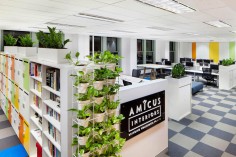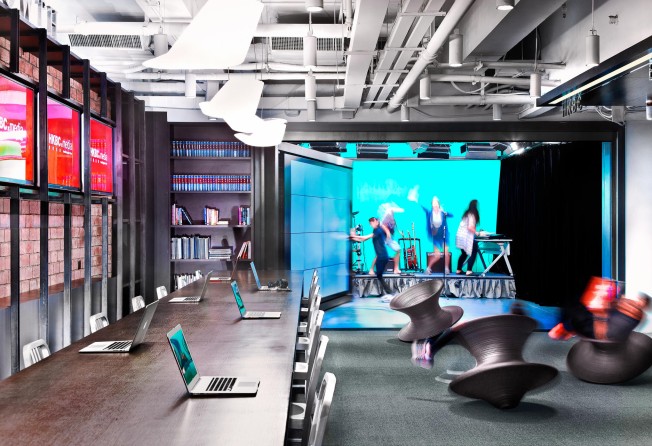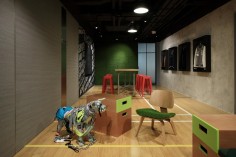
Redesigned offices give workers freedom to hatch fresh ideas

We are supposed to be in the era of working remotely. What with cloud computing and teleconferencing, desk jockeys can technically contribute from anywhere - and according to a recent Stanford University experiment at the Ctrip call centre in China, the productivity of staff who volunteered to work from home during a nine-month period increased by 13 per cent.
Instead, however, companies are investing a lot of money to make the office a more enticing place. The question is why.
Firms might not be as upfront as Yahoo boss Marissa Mayer, who said, after her controversial decision to end work-from-home flexibility, that "some of the best ideas come from pulling two different ideas together". But with Google and Facebook leading the way by offering free food and onsite adult playgrounds, others have followed, and now defined social gathering places are becoming the new workplace normal.
Ramesh Subramaniam, director - design at M Moser Associates, a workplace specialist - sees this strategy not as a ploy by bosses to keep us back at the grind for longer, but rather, a means to get the creative juices flowing.
"The first purpose of any workspace is to establish itself as the primary point for collaboration and interaction - in other words, be a catalyst to build or establish relationships that form the backbone of any company," he says.
"The office starts to represent a social zone and begins to move away from the sterile environments of yesteryear."

Recognising the importance of the local coffee shop as a social space, more and more companies are trying to integrate that informal cafe culture into their workplaces, he adds. "These informal settings not only encourage people to connect, collaborate and bounce ideas off each other, but also lets them choose how they want to work. This flexibility helps inject energy into the office as well as building it as a social hub."
One success story for the M Moser project is the new Guangzhou campus of mainland internet company Tencent, which converted an old factory building. The project was named one of the best 10 designs in the workspace category in the Asia Pacific Interior Design Awards 2014.
"There are meeting spaces, informal gathering areas and even a gym, all flowing into one another," Ramesh says of the design.
For the site's "typical" office buildings, mezzanine floors serve as social zones that overlook and overlap the ground-floor workspaces, which are meant to be quiet.
Staff members are free to roam through the social zones, engaging in impromptu discussions and perhaps scribbling ideas on the writing boards and washable walls scattered throughout.
"It makes collaboration a natural and instinctive act, rather than a matter of scheduling a meeting," Ramesh says.
Jason Caroline Design employed a similarly playful element into its redesign of the Chai Wan office of Chinagrowth - a 24-hour radio station and multimedia hub.
Principal designer Jason Yung says that, as an around-the-clock operation, the office needed practical facilities such as showers, but the design team went further: besides the necessary production and management zones, they created a library and entertainment zone. The aim was to encourage communication, collaboration and innovation.
"The main library was planned as a heart to promote dialogue among different groups," Yung says. This space can be further extended and merged with the main studio for large group events by opening a large swinging door.
"The recreation zone provided behind the library promotes a healthy and playful environment for employees," he says.
"There are ample choices for taking time out during the workday besides the showers and snack bar. The entertainment area is equipped with gym facilities [such as a punching bag, treadmill and ping-pong table] adjacent to the green plant wall and private phone booths."
Kevin Lim Chin-kwok, founder and managing director of OpenUU, believes the workplace design trend is about bosses seeking a happy medium: they want an office space where staff don't mind spending time as the need arises. So remote work options will still be on the table, he feels, without losing the social aspect, which is also productive.
"A lot of companies want to create spaces where you don't necessarily have to work at your desk, but can go and sit in lounges," Lim says.
For the recent renovation of the conference room facilities at Nike's Hong Kong office, Lim designed a number of breakout pockets, which he describes as "small areas for people to gather in a team atmosphere".

"A serious conference room situation might intimidate some people and limit creativity in a way," Lim says. "Even executives want a casual conversation at a coffee shop sometimes, and it's far more convenient to do this within the office."
Citing the Google work style - observed by Lim during a visit to its Silicon Valley headquarters in California - he believes it's an investment that pays off. "A playful environment makes people want to come to work." "Googlers" have all sorts of activities - tennis, miniature golf, gyms and more - because management wants them to have fun, he says.
There's method to that thinking, of course. Revealing the true extent of the social factor in the workplace, a director of the search giant's British operation once told a conference of business leaders in London why the queues at Google's famous never-ending buffets are intentionally kept long.
"Because we know people will chat while they're waiting. Chats become ideas, and ideas become projects," Dan Cobley was reported as saying.
Even executives want a casual conversation at a coffee shop sometimes
Designer Meryl Pearse, of Australian firm Amicus Interiors, points out that it's not a new idea. A 1940s study, by psychologists Leon Festinger, Stanley Schacter and sociologist Kurt Back, notes the extent to which physical space plays a part in how friendships form.
"So, it's our environment that dictates our levels of satisfaction, sense of well-being and, therefore, productivity," Pearse says. "When we apply these theories to workplace design, we can start to reap the benefits of social space."
Amicus Interiors' recent workplace projects have included flexible spaces for impromptu yoga sessions, designated dining and lounge areas, and an overall "noticeably lighter, definitely more collaborative" design approach.
Within such spaces, Pearse says, people form relationships that make them happier and more productive.
"In addition, though, because this is a workplace, they're not just having a chat," she says. "Social spaces are conducive to idea sharing and information exchange. Some of the best ideas are formed in a relaxed environment."